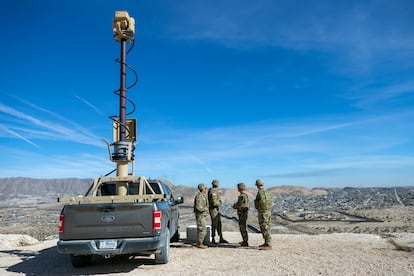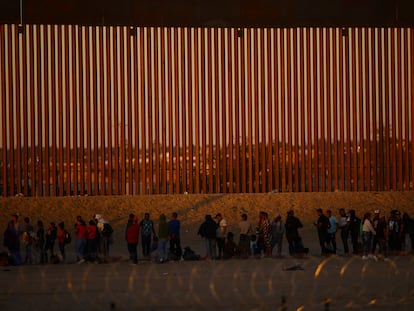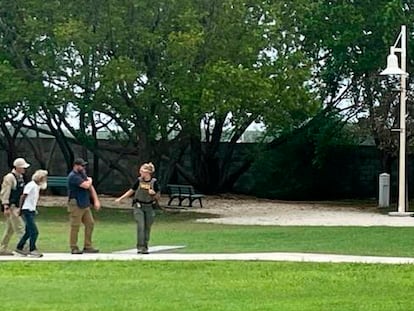The US Army’s silent takeover of the border expands into new areas of Texas and Arizona
It is unclear how National Defense Areas will affect the hundreds of landowners along the river. Some reports quote the Army warning New Mexico hunters and hikers they could be prosecuted for entering the new military zones


Little by little, a large section of the US-Mexico border is being converted into military territory. The expansion of the so-called National Defense Areas (NDAs), which, since April, have been transferred to the Army under a similar system to the one regulating conventional military bases, continues. Last week authorities announced two new NDAs, one in Texas and another one in Arizona. Along with the other two previously created in recent months, it means that over 600 miles of land adjacent to the border would, in practice, become the Army’s property, thus empowering the military to arrest migrants—even though on paper this can only be done by civilian security forces.
These land transfers are going ahead in a much more quiet way than the headline-grabbing raids or the deployment of the National Guard in several states, but they represent yet another step in the militarization of immigration control that Donald Trump has promoted since the first day of his second term in office.
The first new NDA will be administered as part of Joint Base San Antonio and will cover approximately 250 miles (400 kilometers) along the Rio Grande in Hidalgo and Cameron counties in far southeastern Texas, according to an Air Force statement. The other NDA, which will cover about 100 miles (160 kilometers) in western Arizona and will be considered part of the Marine Corps Air Station in Yuma according to multiple reports, although there has been no official announcement. That’s in addition to the NDA covering 63 miles (100 kilometers) from Fort Bliss in El Paso, and another one in New Mexico that encompasses nearly all of the state’s 170 miles (270 kilometers) of border.
Since their creation in mid-April, NDAs have been controversial. According to the Trump Administration, these are federal lands designated as military areas, allowing military personnel to patrol, detain individuals for trespassing, and conduct “law enforcement operations.” Critics, including the nonpartisan Brennan Center for Justice, have warned that the strategy is designed to circumvent the Posse Comitatus Act, which prohibits federal armed forces from engaging in domestic law enforcement duties that fall to civilians. The center’s lawyers argue that this permission must be granted by the legislature or the Constitution.
But the criticism hasn’t translated into legal challenges, and the NDAs are already working efficiently and generating some 1,400 migrant arrests in just a couple of months, according to the Associated Press. The arrests have been for trespassing on military soil, but the migrants are quickly transferred to the custody of immigration authorities, who add their own charges for illegal entry into the United States. Thus, the NDAs have become part of a deployment that has drastically reduced, by more than 90%, illegal crossings along the entire southern border since Trump returned to the White House. In May, the most recent month for which records are kept, there were 12,452 encounters with undocumented migrants, compared to 170,000 the same month last year, or 240,000 in 2022.
While there has been resistance to pursuing national security charges for trespassing in militarized zones, which carry a potential penalty of 18 months in prison—a judge in New Mexico dismissed more than 100 cases against migrants on the grounds that the defendants didn’t know they were entering a restricted area—federal illegal entry charges are not debatable. This was made clear a few weeks ago by interim U.S. Attorney for the Western District of Texas Justin Simmons: “The charges from my office related to these NDAs are not going away. We’re going to keep bringing them. We may win, we may not... At the end of the day, you’re not going to be allowed to remain in this country if you enter illegally.”
The question of land ownership of the new NDA in Texas
In the Rio Grande Valley, the vast majority of the land bordering the river is privately owned. This is part of what made border wall construction difficult in this area in the past. Private land ownership forced the federal government to sue landowners to obtain part of their land.
But in the case of Texas’ new NDA, the key lies in the river itself. Since it serves as the international boundary between the United States and Mexico, it is jointly managed by both nations. On the U.S. side, the International Boundary and Water Commission (IBWC) is in charge. Because the river’s course and trajectory can change, potentially causing the United States to cede or gain new land as the international boundary line shifts, the IBWC maintains control of the river. That control is partly what allowed the commission to sue a private landowner in late 2019 who had begun building a stretch of private border wall just feet from the water during Trump’s first term.
In the statement announcing the new NDA, the Army states that it is being established on land “transferred” to it by the IBWC. The 400 kilometers in question likely encompass every inch of riverbank that winds through the state’s two southeasternmost counties.
But it is still unclear how the NDA designation will affect the hundreds of landowners along the river. In New Mexico, the Army told ranchers they would be allowed to “pass through” without trouble to tend to cattle herds grazing on federal land grants and leases. However, other reports quote the Army warning New Mexico hunters and hikers that they could be prosecuted for entering the new military zones.
Sign up for our weekly newsletter to get more English-language news coverage from EL PAÍS USA Edition
Tu suscripción se está usando en otro dispositivo
¿Quieres añadir otro usuario a tu suscripción?
Si continúas leyendo en este dispositivo, no se podrá leer en el otro.
FlechaTu suscripción se está usando en otro dispositivo y solo puedes acceder a EL PAÍS desde un dispositivo a la vez.
Si quieres compartir tu cuenta, cambia tu suscripción a la modalidad Premium, así podrás añadir otro usuario. Cada uno accederá con su propia cuenta de email, lo que os permitirá personalizar vuestra experiencia en EL PAÍS.
¿Tienes una suscripción de empresa? Accede aquí para contratar más cuentas.
En el caso de no saber quién está usando tu cuenta, te recomendamos cambiar tu contraseña aquí.
Si decides continuar compartiendo tu cuenta, este mensaje se mostrará en tu dispositivo y en el de la otra persona que está usando tu cuenta de forma indefinida, afectando a tu experiencia de lectura. Puedes consultar aquí los términos y condiciones de la suscripción digital.
More information
Archived In
Últimas noticias
Welcome to the post-religion era: The idea of Christianity as the absolute truth has become obsolete
‘I thought you would like it’: The risky sexual practice popularized by TV shows and TikTok
The digitalization of tourism: ‘They promise experiences and gave us the worst possible one’
Mexican peso defies uncertainty with forecasts of a new period of stability in 2026
Most viewed
- Sinaloa Cartel war is taking its toll on Los Chapitos
- Oona Chaplin: ‘I told James Cameron that I was living in a treehouse and starting a permaculture project with a friend’
- Reinhard Genzel, Nobel laureate in physics: ‘One-minute videos will never give you the truth’
- Why the price of coffee has skyrocketed: from Brazilian plantations to specialty coffee houses
- Silver prices are going crazy: This is what’s fueling the rally










































